Greenpeace blames huge surge in deforestation on Brazilian government’s ‘anti-environmental agenda’Greenpeace activists in Brazil have captured shocking images of fires burning in the Amazon rainforest.
There is currently a government ban on fires in states including Mato Grosso — a large state in western central Brazil — where the photographs were taken between 7 and 10 July.
Despite the ban, there are 4,437 hotspots in Mato Grosso and the state has had the highest number of fires this year — representing almost half (49.5 per cent) of all the fires in the Brazilian Amazon in 2020.
Greenpeace said the “illegal” destruction has been needlessly exacerbated by right-wing president Jair Bolsonaro’s “anti-environmental agenda”.
“These images, along with the record deforestation rates this year, are the intended outcome of Bolsonaro’s long term strategy for the Amazon,” claimed Romulo Batista, Greenpeace Brazil Amazon campaigner.
images reveal spread of Amazon fires ahead of dry season
“His government has been dismantling environmental protection laws and kneecapping the power of the environmental protection agencies since Bolsonaro took office, going as far as using the Covid-19 pandemic as a smokescreen to further enable deforestation, logging and mining in the Amazon.”
He added: “This administration is doing nothing but putting the climate and more lives at risk, especially those of indigenous peoples.”
Fires in the Brazilian Amazon increased by 20 per cent in June, reaching a 13-year-high for the month according to government data, and scientists have warned the region is on track for a repeat of last year’s devastating blazes.

A fire burns in the rainforest next to a freshly deforested area in Alta Floresta, Mato Grosso state, Brazil (Christian Braga / Greenpeace)
Meanwhile health experts also fear smoke from fires during the dry season is worsening respiratory problems due to air pollution and complicating tackling vast numbers of coronavirus cases. More than 76,000 people have died of Covid-19 in Brazil and the country has seen more than 2 million cases overall.
In June, Brazil’s government space research agency, INPE, detected 2,248 fires in the Amazon rainforest, up from 1,880 in June 2019.
Greenpeace said large fires in the Amazon rainforest “do not occur naturally, but are deliberately set by farmers or land grabbers to expand the land used for cattle ranching and industrial agriculture production”.
Mr Bolsonaro has been criticised for dismantling forest protections that had helped a record reduction in deforestation between 2004 and 2012. Deforestation in the Amazon has soared in recent years, reaching an 11-year high in 2019.
Indigenous peoples, already dealing with the risks of Covid-19, are believed to be at considerably higher risk due to the fires, which, as they intensify, mean greater quantities of air pollution are affecting the region.
Read more
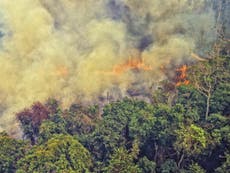
“His government has been dismantling environmental protection laws and kneecapping the power of the environmental protection agencies since Bolsonaro took office, going as far as using the Covid-19 pandemic as a smokescreen to further enable deforestation, logging and mining in the Amazon.”
He added: “This administration is doing nothing but putting the climate and more lives at risk, especially those of indigenous peoples.”
Fires in the Brazilian Amazon increased by 20 per cent in June, reaching a 13-year-high for the month according to government data, and scientists have warned the region is on track for a repeat of last year’s devastating blazes.

A fire burns in the rainforest next to a freshly deforested area in Alta Floresta, Mato Grosso state, Brazil (Christian Braga / Greenpeace)
Meanwhile health experts also fear smoke from fires during the dry season is worsening respiratory problems due to air pollution and complicating tackling vast numbers of coronavirus cases. More than 76,000 people have died of Covid-19 in Brazil and the country has seen more than 2 million cases overall.
In June, Brazil’s government space research agency, INPE, detected 2,248 fires in the Amazon rainforest, up from 1,880 in June 2019.
Greenpeace said large fires in the Amazon rainforest “do not occur naturally, but are deliberately set by farmers or land grabbers to expand the land used for cattle ranching and industrial agriculture production”.
Mr Bolsonaro has been criticised for dismantling forest protections that had helped a record reduction in deforestation between 2004 and 2012. Deforestation in the Amazon has soared in recent years, reaching an 11-year high in 2019.
Indigenous peoples, already dealing with the risks of Covid-19, are believed to be at considerably higher risk due to the fires, which, as they intensify, mean greater quantities of air pollution are affecting the region.
Read more

UK consumption ‘fuelling Amazon fires’
Mr Bolsonaro’s response to the fires “has been performative and ineffective”, Greenpeace said and cited moves such as deploying the army in costly and unsuccessful operations to fight deforestation, as well as the announcement of his “insufficient” 120-day-long “fires moratorium”.
Mr Batista said: “As Bolsonaro’s 2019 fire moratorium already showed, banning fires alone doesn’t work. Protecting the capacity to monitor and stop environmental destruction and to enforce the law — which Bolsonaro continues to systematically dismantle — is essential. Those calling for action of the Brazilian government cannot fool themselves and think that Bolsonaro’s sloppy PR moves will have any meaningful impacts.”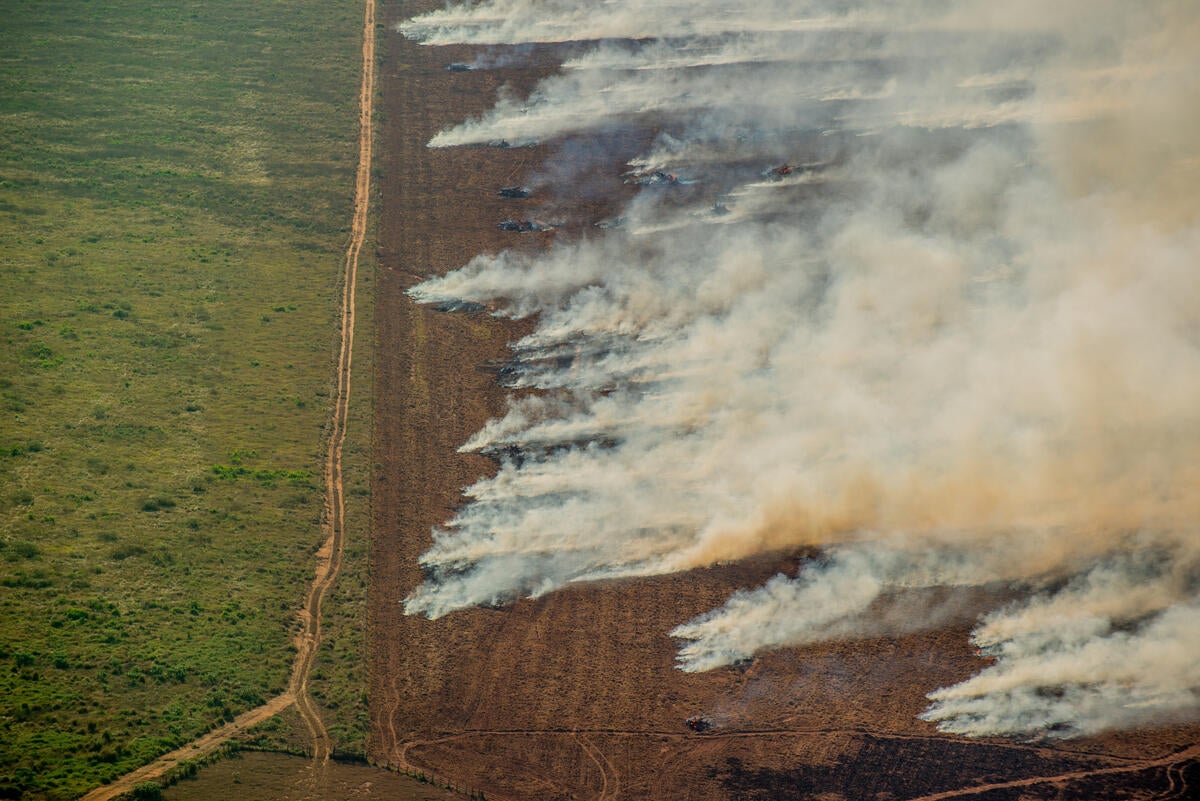
Hotspot next to a deforested area in Nova Maringá, Mato Grosso state (Christian Braga / Greenpeace)
International demand for goods including soy, timber, paper, beef and leather are among the key drivers of land clearances in the Amazon.
Last week, data from the WWF and the RSPB revealed the extent of the UK’s demand for goods linked to the destruction.
Brazil represents 13.9 per cent of the total UK overseas land footprint, meaning we currently rely on an average of more than 800,000 hectares of land — much of which was once rainforest — to supply our demand for agricultural products. This is equivalent to five times the size of Greater London.
Satellite images reveal spread of Amazon fires amid fears over deforestation in looming dry season
Mr Bolsonaro’s response to the fires “has been performative and ineffective”, Greenpeace said and cited moves such as deploying the army in costly and unsuccessful operations to fight deforestation, as well as the announcement of his “insufficient” 120-day-long “fires moratorium”.
Mr Batista said: “As Bolsonaro’s 2019 fire moratorium already showed, banning fires alone doesn’t work. Protecting the capacity to monitor and stop environmental destruction and to enforce the law — which Bolsonaro continues to systematically dismantle — is essential. Those calling for action of the Brazilian government cannot fool themselves and think that Bolsonaro’s sloppy PR moves will have any meaningful impacts.”

Hotspot next to a deforested area in Nova Maringá, Mato Grosso state (Christian Braga / Greenpeace)
International demand for goods including soy, timber, paper, beef and leather are among the key drivers of land clearances in the Amazon.
Last week, data from the WWF and the RSPB revealed the extent of the UK’s demand for goods linked to the destruction.
Brazil represents 13.9 per cent of the total UK overseas land footprint, meaning we currently rely on an average of more than 800,000 hectares of land — much of which was once rainforest — to supply our demand for agricultural products. This is equivalent to five times the size of Greater London.
Satellite images reveal spread of Amazon fires amid fears over deforestation in looming dry season
'This is just the beginning. Over the next few months, unless we see strong intervention, fires will be likely to increase... worsening the climate crisis globally' said Greenpeace
Louise Boyle New York @Friday 3 July 2020
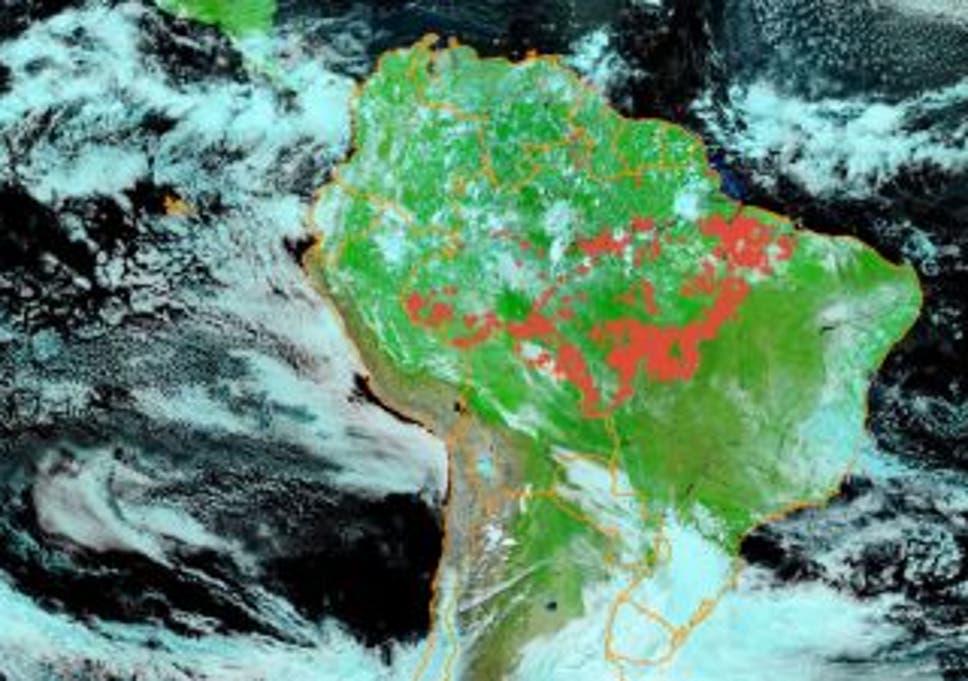
Aerial images of fires in Amazon rainforest with the red dots representing fire hotspots in June 2020 ( INPE/Brazilian National Institute for Space Research )
Satellite images of Brazil's Amazon rainforest in June show thousands of fires raging as dry season approaches, with conservationists warning that the region could be on track for a repeat of last year’s devastating blazes.
Brazil’s government space research agency, INPE, detected 2,248 fires in the Amazon rainforest last month, a 20 per cent increase from the 1,880 fires in June 2019. It was the worst June for fires in more than a decade, according to government data.
Health experts also expressed concern that smoke from the fires could lead to respiratory problems in the population and complicate tackling Brazil's vast number of coronavirus cases. More than 60,000 people have died of Covid-19 in Brazil and 1.4million have been infected, the World Health Organisation reported.
Louise Boyle New York @Friday 3 July 2020

Aerial images of fires in Amazon rainforest with the red dots representing fire hotspots in June 2020 ( INPE/Brazilian National Institute for Space Research )
Satellite images of Brazil's Amazon rainforest in June show thousands of fires raging as dry season approaches, with conservationists warning that the region could be on track for a repeat of last year’s devastating blazes.
Brazil’s government space research agency, INPE, detected 2,248 fires in the Amazon rainforest last month, a 20 per cent increase from the 1,880 fires in June 2019. It was the worst June for fires in more than a decade, according to government data.
Health experts also expressed concern that smoke from the fires could lead to respiratory problems in the population and complicate tackling Brazil's vast number of coronavirus cases. More than 60,000 people have died of Covid-19 in Brazil and 1.4million have been infected, the World Health Organisation reported.
Chief of indigenous Amazon tribe dies with coronavirus
Anna Jones, Greenpeace UK Head of Forests, said: “These fires are no accident. Brazil’s President, Jair Bolsonaro, has done nothing to discourage ranchers and land grabbers to stop deforesting the Amazon. Despite the Covid-19 pandemic, deforestation has soared and now we are seeing fires deliberately lit to clear that land for industrial agriculture.
Anna Jones, Greenpeace UK Head of Forests, said: “These fires are no accident. Brazil’s President, Jair Bolsonaro, has done nothing to discourage ranchers and land grabbers to stop deforesting the Amazon. Despite the Covid-19 pandemic, deforestation has soared and now we are seeing fires deliberately lit to clear that land for industrial agriculture.
“This is just the beginning. Over the next few months, unless we see strong intervention, fires will be likely to increase and engulf vast areas of forest, endangering the lives of Indigenous Peoples, wildlife and worsening the climate crisis globally."
June 2020 averaged around 75 fires per day in the Amazon, compared with an average of nearly 1,000 blazes a day when fires peaked in August 2019.
“It’s a bad sign, but what really is going to count is what happens from now on,” Philip Fearnside, an ecologist at Brazil’s National Institute of Amazonian Research, told Reuters.
Deforestation is up 34 per cent in the first five months of the year from a year ago, preliminary INPE data shows.
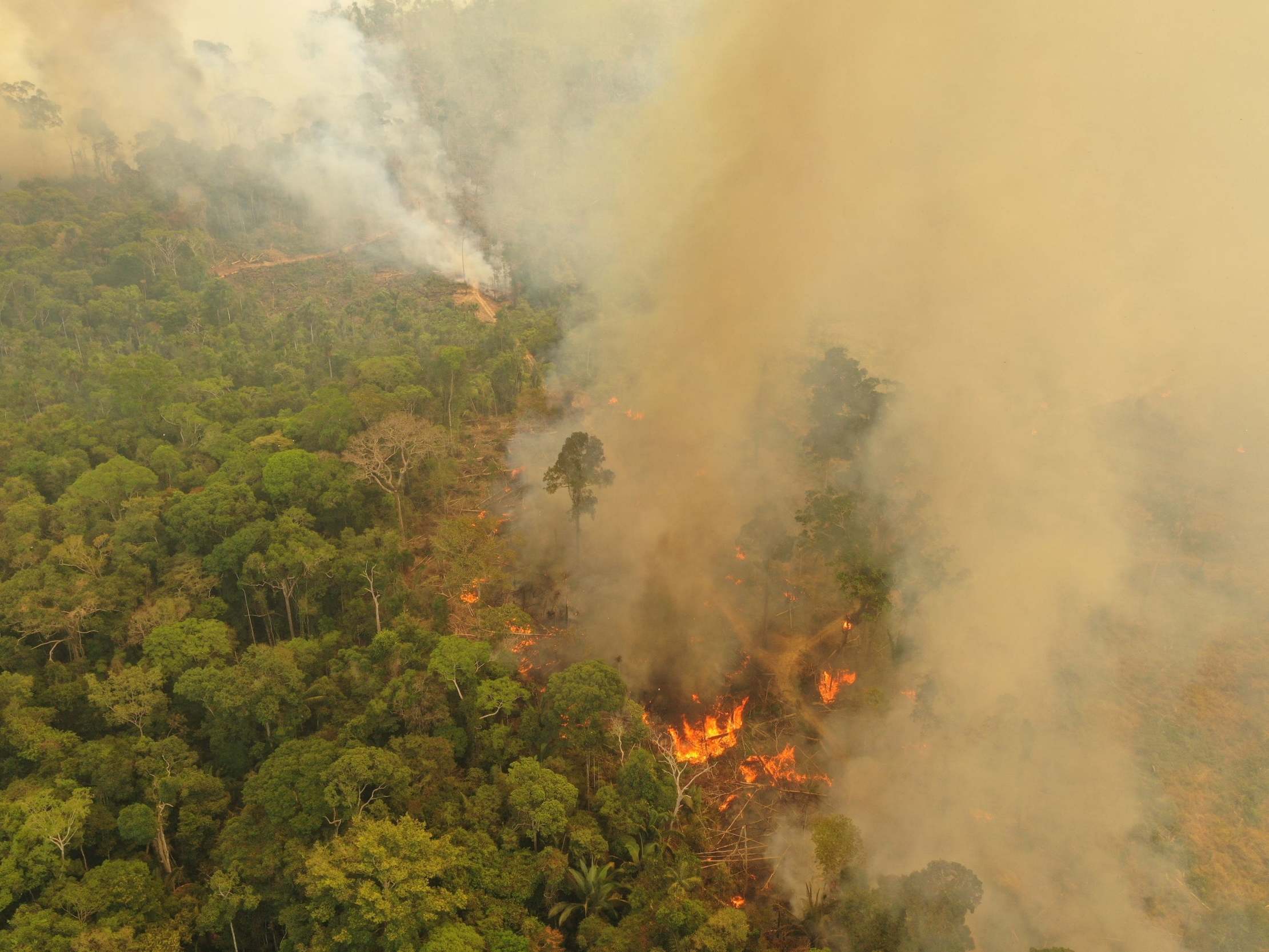
A fire burning in Porto Velho, Brazil, one of the world's oldest and most diverse tropical ecosystems and one of the most endangered on the planet (Michael Dantas/WWF/PA Wire)
Each year the Amazon absorbs around 2bn tonnes of carbon dioxide produced by burning fossil fuels, playing a crucial role in mitigating the growing climate crisis. Carlos Nobre, a University of Sao Paulo climate scientist, told AP that the Amazon acts as a “sink” - draining heat-trapping CO2 from the atmosphere.
Some 40bn tonnes of CO2 are emitted globally each year. Fires in the Amazon pose a double threat: not only do they destroy the forests needed to absorb carbon but the blazes spew millions of tonnes of CO2 into the atmosphere.
Wildfires are sparked in the Amazon by land-grabbers who slash and burn through the forest to make way for cattle and crops. Mr Bolsonaro has been criticised for dismantling forest protections that had helped a record reduction in deforestation between 2004 and 2012. Deforestation in the Amazon has soared in recent years, reaching an 11-year high in 2019.
Watch more
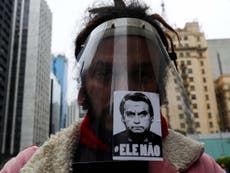
June 2020 averaged around 75 fires per day in the Amazon, compared with an average of nearly 1,000 blazes a day when fires peaked in August 2019.
“It’s a bad sign, but what really is going to count is what happens from now on,” Philip Fearnside, an ecologist at Brazil’s National Institute of Amazonian Research, told Reuters.
Deforestation is up 34 per cent in the first five months of the year from a year ago, preliminary INPE data shows.

A fire burning in Porto Velho, Brazil, one of the world's oldest and most diverse tropical ecosystems and one of the most endangered on the planet (Michael Dantas/WWF/PA Wire)
Each year the Amazon absorbs around 2bn tonnes of carbon dioxide produced by burning fossil fuels, playing a crucial role in mitigating the growing climate crisis. Carlos Nobre, a University of Sao Paulo climate scientist, told AP that the Amazon acts as a “sink” - draining heat-trapping CO2 from the atmosphere.
Some 40bn tonnes of CO2 are emitted globally each year. Fires in the Amazon pose a double threat: not only do they destroy the forests needed to absorb carbon but the blazes spew millions of tonnes of CO2 into the atmosphere.
Wildfires are sparked in the Amazon by land-grabbers who slash and burn through the forest to make way for cattle and crops. Mr Bolsonaro has been criticised for dismantling forest protections that had helped a record reduction in deforestation between 2004 and 2012. Deforestation in the Amazon has soared in recent years, reaching an 11-year high in 2019.
Watch more

Brazil becomes second country to pass 1 million Covid-19 cases
Mr Bolsonaro has called for more farming and mining in protected areas of the Amazon. He deployed the armed forces to protect the Amazon in May as he did in August last year. Despite that initiative, deforestation rose 12 per cent in May from a year earlier and increased in June.
“When the dry season arrives in the Amazon, these felled trees will become fuel for burning. This was the main ingredient of the 2019 fire season, a story that can repeat itself in 2020 if nothing is done to prevent it," said Ane Alencar, director of science at the Amazon Environmental Research Institute (IPAM), a non-governmental organisation.
Communities in the Amazon are bracing for the smoke that blankets the region during the fire season, typically at a peak from August to November.
Guilherme Pivoto, an infectologist in Amazonas state, told Reuters that worsening air quality could impact coronavirus patients. The state, in the northern region of the Amazon rainforest, has been one of Brazil's hardest-hit by the pandemic.
“Those that contract Covid have a higher chance of an interaction between the pollution and Covid-19, causing drawn-out cases with more symptoms,” Mr Pivoto said.
The number of coronavirus cases in Brazil is second only to the US. However, health experts believe the actual number of cases in Brazil could be up to seven times higher than the official statistics. Johns Hopkins University said the country is performing an average of 14 tests per 100,000 people per day, as much as 20 times less than what is needed to track the virus.
Additional reporting by Reuters
Mr Bolsonaro has called for more farming and mining in protected areas of the Amazon. He deployed the armed forces to protect the Amazon in May as he did in August last year. Despite that initiative, deforestation rose 12 per cent in May from a year earlier and increased in June.
“When the dry season arrives in the Amazon, these felled trees will become fuel for burning. This was the main ingredient of the 2019 fire season, a story that can repeat itself in 2020 if nothing is done to prevent it," said Ane Alencar, director of science at the Amazon Environmental Research Institute (IPAM), a non-governmental organisation.
Communities in the Amazon are bracing for the smoke that blankets the region during the fire season, typically at a peak from August to November.
Guilherme Pivoto, an infectologist in Amazonas state, told Reuters that worsening air quality could impact coronavirus patients. The state, in the northern region of the Amazon rainforest, has been one of Brazil's hardest-hit by the pandemic.
“Those that contract Covid have a higher chance of an interaction between the pollution and Covid-19, causing drawn-out cases with more symptoms,” Mr Pivoto said.
The number of coronavirus cases in Brazil is second only to the US. However, health experts believe the actual number of cases in Brazil could be up to seven times higher than the official statistics. Johns Hopkins University said the country is performing an average of 14 tests per 100,000 people per day, as much as 20 times less than what is needed to track the virus.
Additional reporting by Reuters
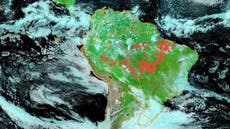

No comments:
Post a Comment